Grain Structure and Texture Evolution in the Bottom Zone of Dissimilar Friction-Stir-Welded AA2024-T351 and AA7075-T651 Joints
Abstract
:1. Introduction
2. Experimental Details
3. Results and Discussion
4. Conclusions
- Dynamic recrystallization occurs in the bottom zones of dissimilar FSW joints, resulting in the formation of equiaxed grains. A low grain size with the range of 1.46–1.72 μm is obtained at the welding speed from 60 mm/min to 240 mm/min.
- A low welding speed results in the formation of a low fraction of LAGBs and a high fraction of the recrystallized grains, while a high welding speed produces a high fraction of LAGBs and substructured grains in the bottom zone.
- The and components are markedly decreased with an increase in welding speed from 60 mm/min to 240 mm/min, while the other shear texture components show almost no significant changes at different welding speeds. The total number of shear textures in the bottom zone is decreased at a high welding speed compared to other joints.
- A low welding speed produces high heat input, which results in a low microhardness value in the HAZ on the AS.
Author Contributions
Funding
Institutional Review Board Statement
Informed Consent Statement
Data Availability Statement
Conflicts of Interest
References
- Ahmed, M.M.Z.; Seleman, M.M.E.-S.; Fydrych, D.; Çam, G. Friction stir welding of aluminum in the aerospace industry: The current progress and state-of-the-art review. Materials 2023, 16, 2971. [Google Scholar] [CrossRef]
- Dursun, T.; Soutis, C. Recent developments in advanced aircraft aluminium alloys. Mater. Des. 2014, 56, 862–871. [Google Scholar] [CrossRef]
- Dong, J.; Zhang, D.; Zhang, W.; Cao, G.; Qiu, C. Effect of post-weld heat treatments on the microstructure and mechanical properties of underwater friction stir welded joints of 7003-T4/6060-T4 aluminium alloys. Mater. Sci. Eng. A 2023, 862, 144423. [Google Scholar] [CrossRef]
- Insua, P.; Nakkiew, W.; Wisittipanich, W. Post Weld Heat Treatment Optimization of Dissimilar Friction Stir Welded AA2024-T3 and AA7075-T651 Using Machine Learning and Metaheuristics. Materials 2023, 16, 2081. [Google Scholar] [CrossRef] [PubMed]
- Zhang, C.; Huang, G.; Cao, Y.; Wu, X.; Huang, X.; Liu, Q. Optimization of tensile and corrosion properties of dissimilar friction stir welded AA2024-7075 joints. J. Mater. Eng. Perform. 2018, 28, 183–199. [Google Scholar] [CrossRef]
- Farhang, M.; Farahani, M.; Nazari, M.; Sam-Daliri, O. Experimental Correlation Between Microstructure, Residual Stresses and Mechanical Properties of Friction Stir Welded 2024-T6 Aluminum Alloys. Int. J. Adv. Des. Manuf. Technol. 2022, 15, 1–9. [Google Scholar] [CrossRef]
- Butola, R.; Choudhary, N.; Kumar, R.; Mouria, P.K.; Zubair, M.; Singari, R.M. Measurement of residual stress on H13 tool steel during machining for fabrication of FSW/FSP tool pins. Mater. Today Proc. 2021, 43, 256–262. [Google Scholar] [CrossRef]
- de Viveiros, B.V.G.; da Silva, R.M.P.; Donatus, U.; Costa, I. Welding and galvanic coupling effects on the electrochemical activity of dissimilar AA2050 and AA7050 aluminum alloys welded by Friction Stir Welding (FSW). Electrochim. Acta 2023, 449, 142196. [Google Scholar] [CrossRef]
- Sharma, C.; Bit, S.D.; Tripathi, A.; Verma, V.; Upadhyay, V. Material Flow Behavior in Dissimilar Friction Stir Welds of AA2024 and AA5086 Aluminum Alloys. J. Eng. Res. 2022, 10, 153–159. [Google Scholar] [CrossRef]
- Zhang, C.; Cao, Y.; Huang, G.; Zeng, Q.; Zhu, Y.; Huang, X.; Li, N.; Liu, Q. Influence of tool rotational speed on local micro-structure, mechanical and corrosion behavior of dissimilar AA2024/7075 joints fabricated by friction stir welding. J. Manuf. Process. 2020, 49, 214–226. [Google Scholar] [CrossRef]
- Gao, S.; Wu, C.; Padhy, G.; Shi, L. Evaluation of local strain distribution in ultrasonic enhanced Al 6061-T6 friction stir weld nugget by EBSD analysis. Mater. Des. 2016, 99, 135–144. [Google Scholar] [CrossRef]
- McNelley, T.; Swaminathan, S.; Su, J. Recrystallization mechanisms during friction stir welding/processing of aluminum alloys. Scr. Mater. 2007, 58, 349–354. [Google Scholar] [CrossRef]
- Mironov, S.; Masaki, K.; Sato, Y.S.; Kokawa, H. Texture produced by abnormal grain growth in friction stir-welded aluminum alloy 1050. Met. Mater. Trans. A 2013, 44, 1153–1157. [Google Scholar] [CrossRef]
- Zhang, C.; Huang, G.; Cao, Y.; Zhu, Y.; Liu, Q. On the microstructure and mechanical properties of similar and dissimilar AA7075 and AA2024 friction stir welding joints: Effect of rotational speed. J. Manuf. Process. 2019, 37, 470–487. [Google Scholar] [CrossRef]
- Li, S.; Beyerlein, I.J.; Bourke, M.A. Texture formation during equal channel angular extrusion of fcc and bcc materials: Comparison with simple shear. Mater. Sci. Eng. A 2005, 394, 66–77. [Google Scholar] [CrossRef]
- Chen, S.; Jiang, X. Texture evolution and deformation mechanism in friction stir welding of 2219Al. Mater. Sci. Eng. A 2014, 612, 267–277. [Google Scholar] [CrossRef]
- Shen, J.; Wang, F.; Suhuddin, U.F.H.; Hu, S.; Li, W.; dos Santos, J.F. Crystallographic texture in bobbin tool friction-stir-welded aluminum. Met. Mater. Trans. A 2015, 46, 2809–2813. [Google Scholar] [CrossRef]
- Wang, T.; Zou, Y.; Matsuda, K. Micro-structure and micro-textural studies of friction stir welded AA6061-T6 subjected to different rotation speeds. Mater. Des. 2016, 90, 13–21. [Google Scholar] [CrossRef]
- Imam, M.; Racherla, V.; Biswas, K.; Fujii, H.; Chintapenta, V.; Sun, Y.; Morisada, Y. Microstructure-property relation and evo-lution in friction stir welding of naturally aged 6063 aluminium alloy. Int. J. Adv. Manuf. Tech. 2017, 91, 1753–1769. [Google Scholar] [CrossRef]
- Raturi, M.; Bhattacharya, A. Microstructure and texture correlation of secondary heating assisted dissimilar friction stir welds of aluminum alloys. Mater. Sci. Eng. A 2021, 825, 141891. [Google Scholar] [CrossRef]
- Wang, B.; Lei, B.-B.; Zhu, J.-X.; Feng, Q.; Wang, L.; Wu, D. EBSD study on microstructure and texture of friction stir welded AA5052-O and AA6061-T6 dissimilar joint. Mater. Des. 2015, 87, 593–599. [Google Scholar] [CrossRef]
- Cho, J.-H.; Kim, W.J.; Gil Lee, C. Texture and microstructure evolution and mechanical properties during friction stir welding of extruded aluminum billets. Mater. Sci. Eng. A 2014, 597, 314–323. [Google Scholar] [CrossRef]
- Zhang, C.; Huang, G.; Liu, Q. Quantitative analysis of grain structure and texture evolution of dissimilar AA2024/7075 joints manufactured by friction stir welding. Mater. Today Commun. 2021, 26, 101920. [Google Scholar] [CrossRef]
- Zhang, C.; Huang, G.; Zhang, D.; Sun, Z.; Liu, Q. Microstructure and mechanical properties in dissimilar friction stir welded AA2024/7075 joints at high heat input: Effect of post-weld heat treatment. J. Mater. Res. Technol. 2020, 9, 14771–14782. [Google Scholar] [CrossRef]
- Zhang, C.; Cao, Y.; Cao, L.; Huang, G.; Zhu, Y.; Zhu, J.; Liu, Q. Microstructure, mechanical and corrosion properties of dissimilar friction stir welded aluminum alloys joints. Trans. Nonferr. Metal. Soc. 2019, 29, 11. [Google Scholar]
- Chen, Y.; Ding, H.; Li, J.-Z.; Zhao, J.-W.; Fu, M.-J.; Li, X.-H. Effect of welding heat input and post-welded heat treatment on hardness of stir zone for friction stir-welded 2024-T3 aluminum alloy. Trans. Nonferrous Met. Soc. China 2015, 25, 2524–2532. [Google Scholar] [CrossRef]
- Calcagnotto, M.; Ponge, D.; Demir, E.; Raabe, D. Orientation gradients and geometrically necessary dislocations in ultrafine grained dual-phase steels studied by 2D and 3D EBSD. Mater. Sci. Eng. A 2010, 527, 2738–2746. [Google Scholar] [CrossRef]
- Goriparthi, V.; Nallu, R.; Chebolu, R.; Indupuri, S.; Rudrapati, R. Experimental Studies on Mechanical Behavior of TIG and Friction Stir Welded AA5083 -AA7075 Dissimilar Aluminum Alloys. Adv. Mater. Sci. Eng. 2023, 2023, 1–7. [Google Scholar] [CrossRef]
- Essa, A.R.S.; Eldersy, R.I.A.; Ahmed, M.M.Z.; El-Aty, A.A.; Alamry, A.; Alzahrani, B.; El-Nikhaily, A.E.; Habba, M.I.A. Modeling and experimental investigation of the impact of the hemispherical tool on heat generation and tensile properties of dissimilar friction stir welded AA5083 and AA7075 Al alloys. Materials 2024, 17, 433. [Google Scholar] [CrossRef]

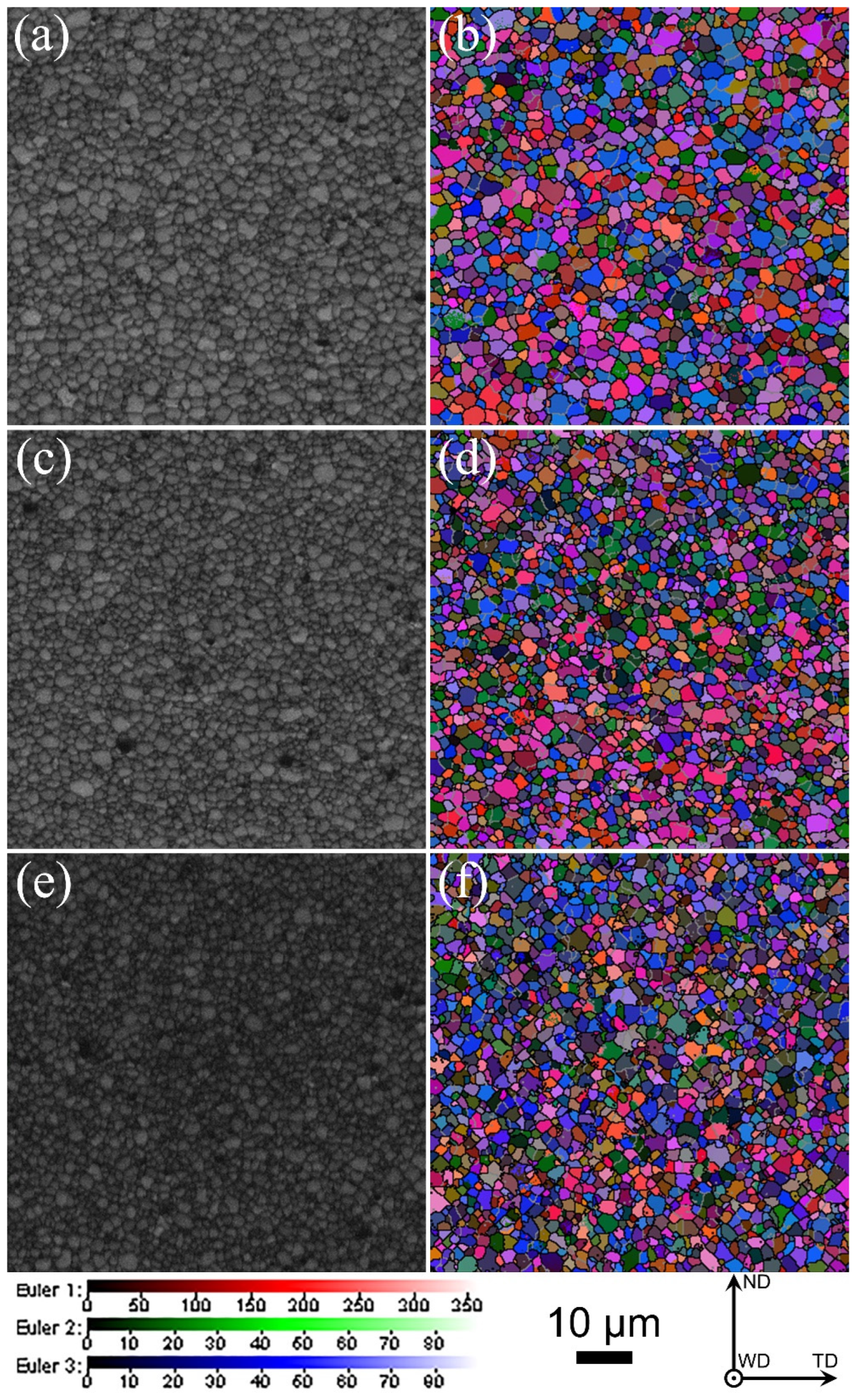
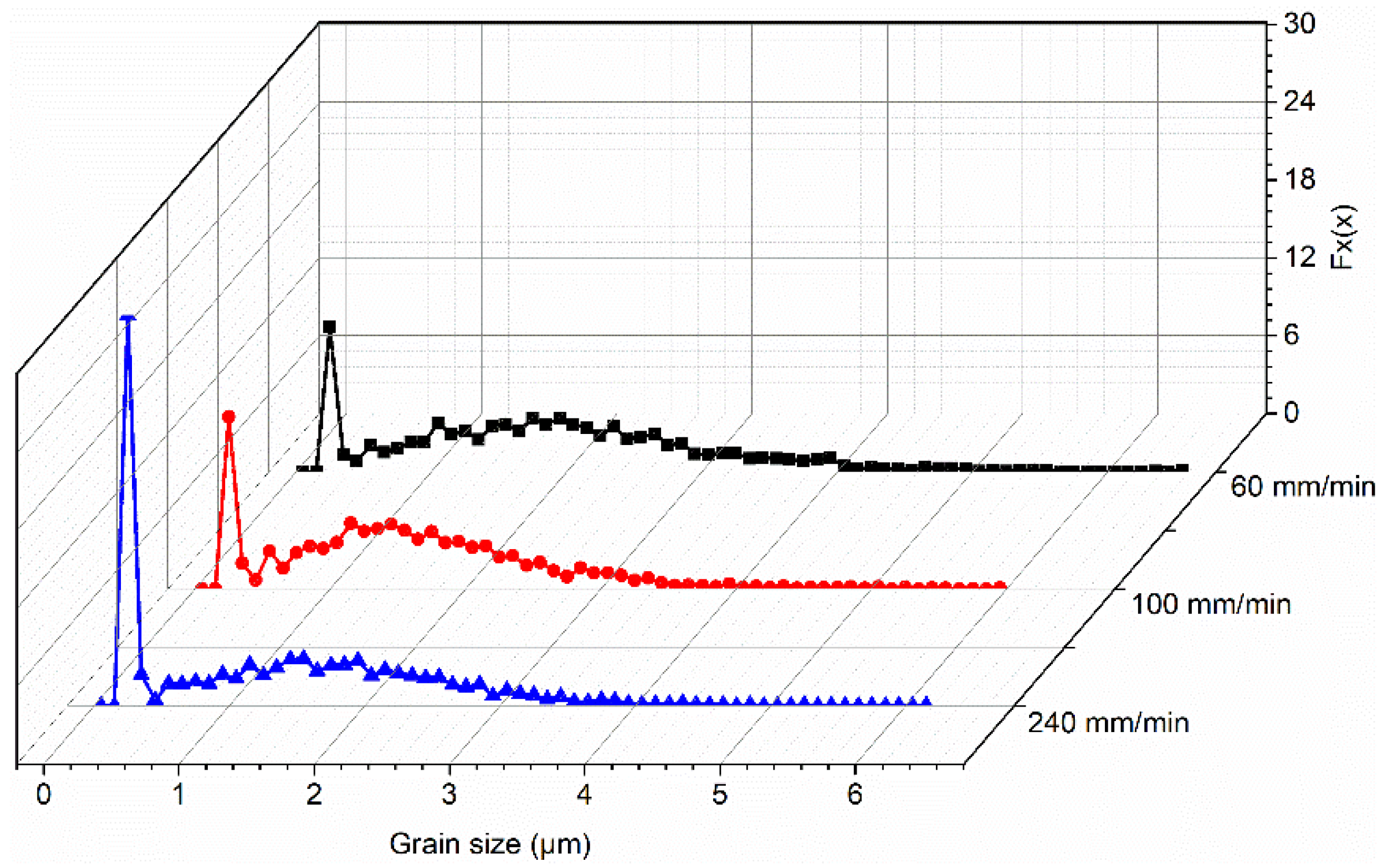
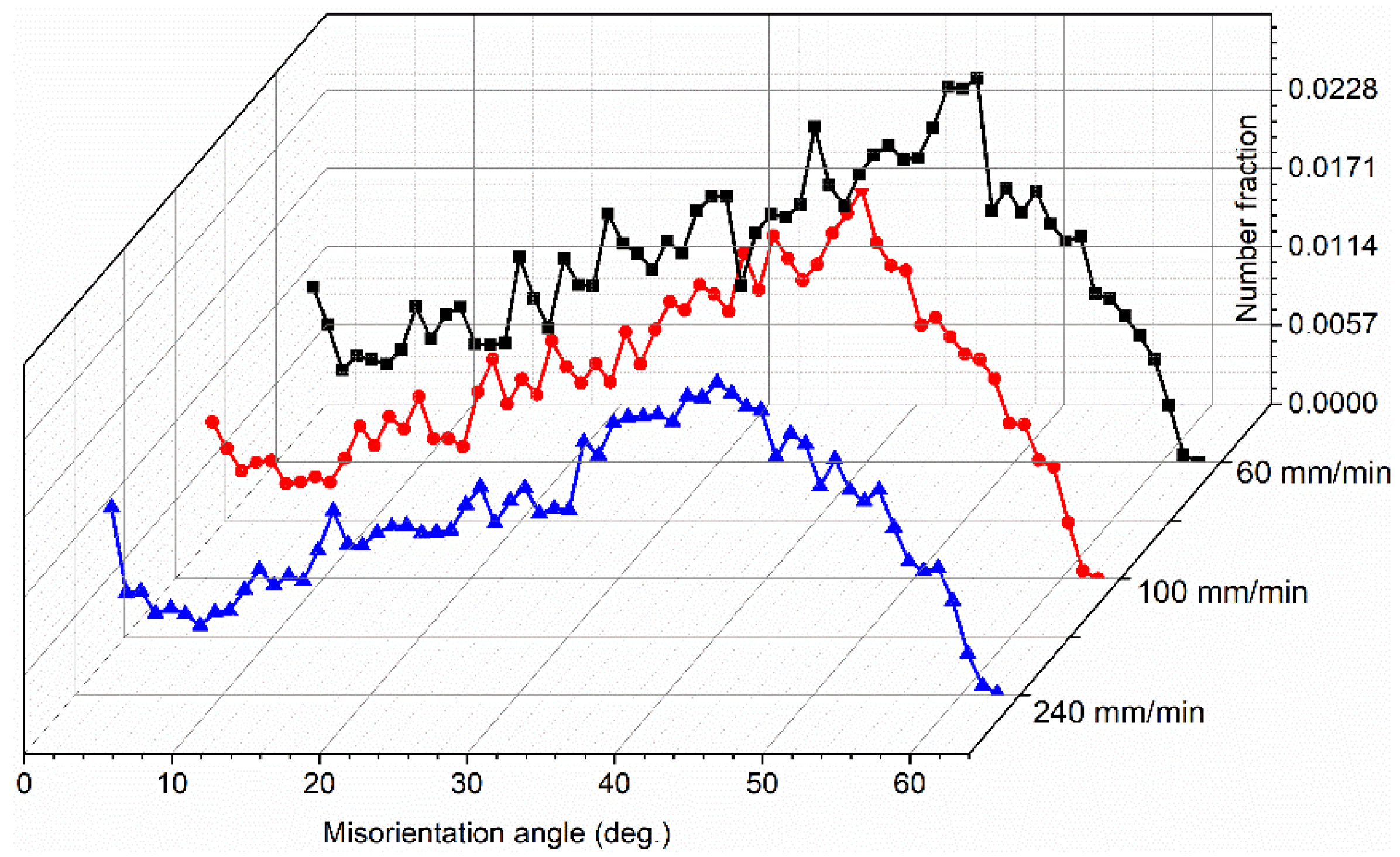
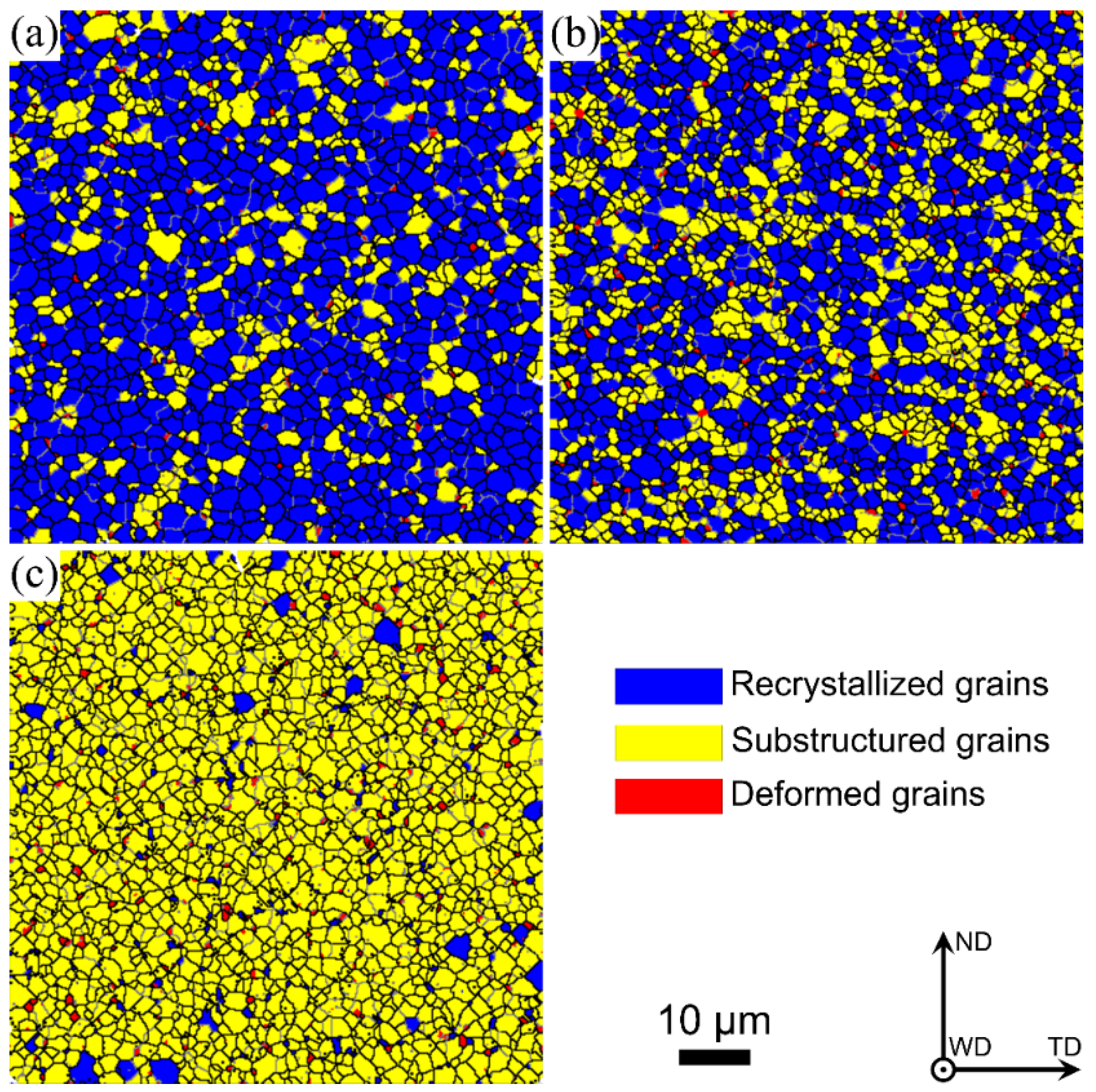


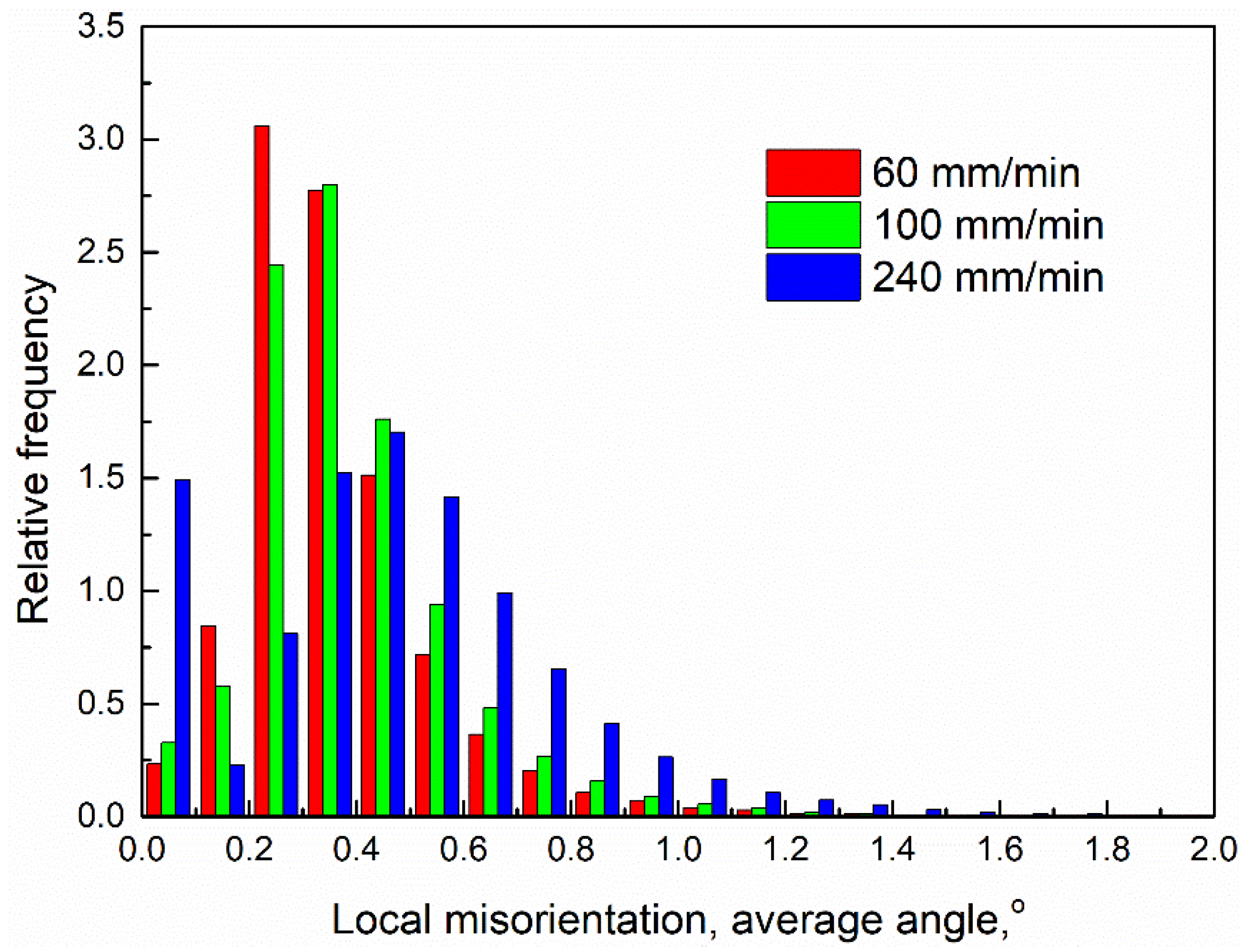
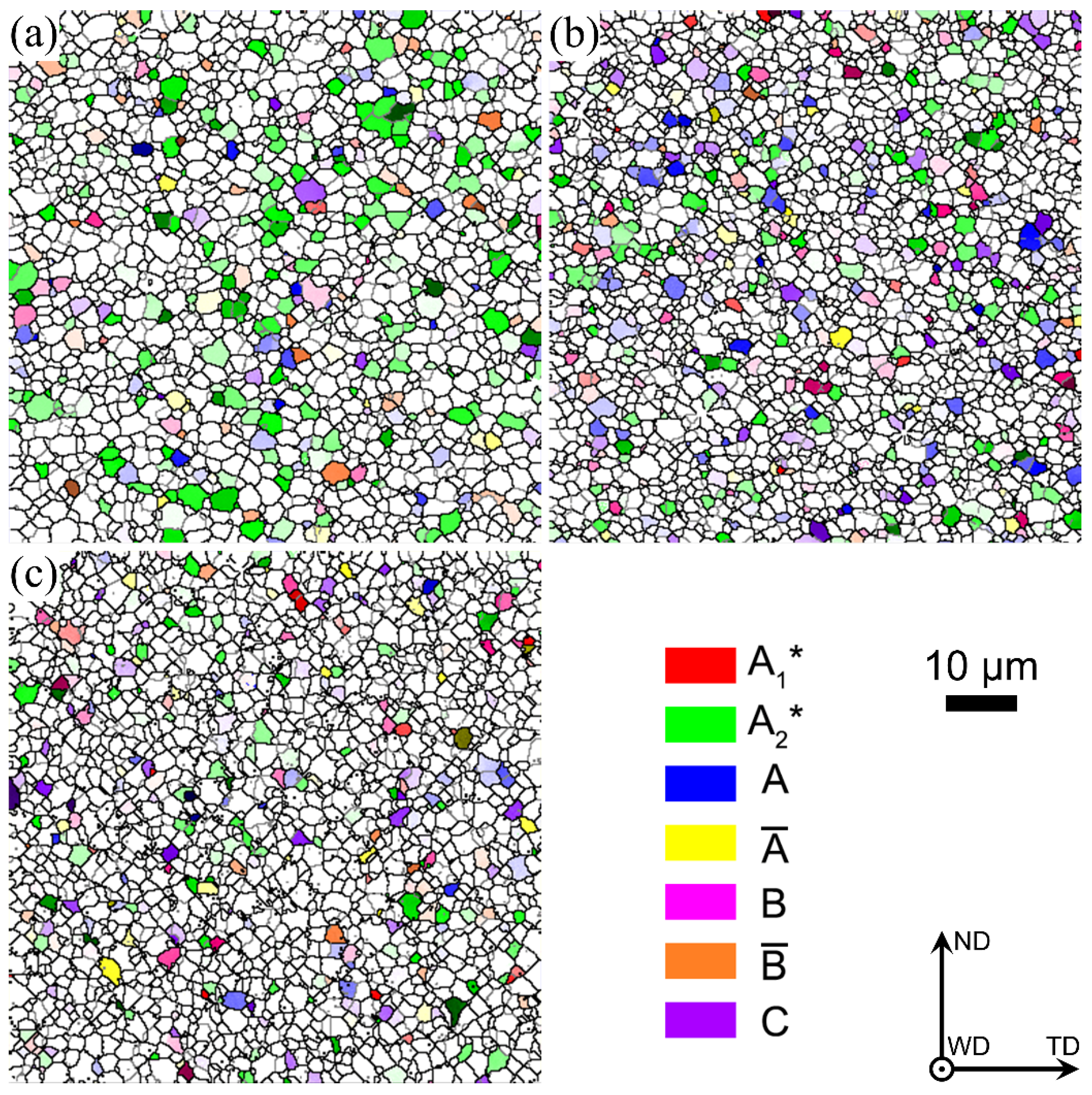

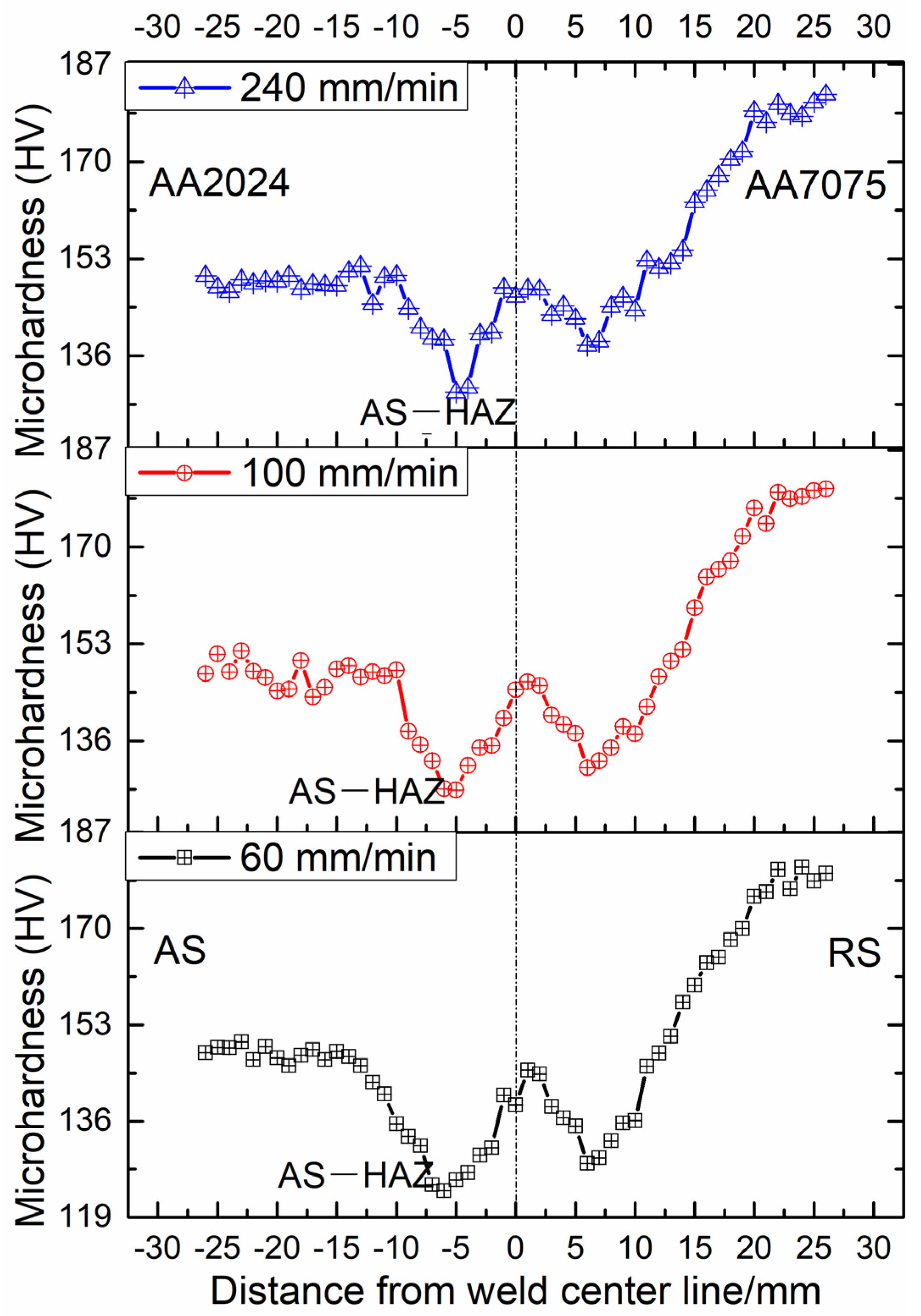
| Welding Speed/mm/min | Recrystallized Grains/% | Substructured Grains/% | Deformed Grains/% |
|---|---|---|---|
| 60 | 75.29 | 23.44 | 1.27 |
| 100 | 60.59 | 37.46 | 1.95 |
| 240 | 4.5 | 92.65 | 2.85 |
| Welding Speed/mm/min | Different Types of Shear Texture Components/% | |||||||
|---|---|---|---|---|---|---|---|---|
| Random | ||||||||
| 60 | 0.168 | 17.6 | 3.35 | 2 | 1.51 | 3.08 | 1.63 | 70.662 |
| 100 | 1.16 | 11.2 | 6.75 | 1.25 | 3.35 | 0.583 | 4.17 | 71.537 |
| 240 | 1.02 | 5.98 | 3.29 | 2.1 | 2.03 | 1.34 | 3.21 | 81.03 |
Disclaimer/Publisher’s Note: The statements, opinions and data contained in all publications are solely those of the individual author(s) and contributor(s) and not of MDPI and/or the editor(s). MDPI and/or the editor(s) disclaim responsibility for any injury to people or property resulting from any ideas, methods, instructions or products referred to in the content. |
© 2024 by the authors. Licensee MDPI, Basel, Switzerland. This article is an open access article distributed under the terms and conditions of the Creative Commons Attribution (CC BY) license (https://creativecommons.org/licenses/by/4.0/).
Share and Cite
Shou, H.; Song, Y.; Zhang, C.; Zhang, P.; Zhao, W.; Zhu, X.; Shi, P.; Xing, S. Grain Structure and Texture Evolution in the Bottom Zone of Dissimilar Friction-Stir-Welded AA2024-T351 and AA7075-T651 Joints. Materials 2024, 17, 3750. https://doi.org/10.3390/ma17153750
Shou H, Song Y, Zhang C, Zhang P, Zhao W, Zhu X, Shi P, Xing S. Grain Structure and Texture Evolution in the Bottom Zone of Dissimilar Friction-Stir-Welded AA2024-T351 and AA7075-T651 Joints. Materials. 2024; 17(15):3750. https://doi.org/10.3390/ma17153750
Chicago/Turabian StyleShou, Haoge, Yaoyao Song, Chenghang Zhang, Pengfei Zhang, Wei Zhao, Xixia Zhu, Peng Shi, and Shule Xing. 2024. "Grain Structure and Texture Evolution in the Bottom Zone of Dissimilar Friction-Stir-Welded AA2024-T351 and AA7075-T651 Joints" Materials 17, no. 15: 3750. https://doi.org/10.3390/ma17153750





